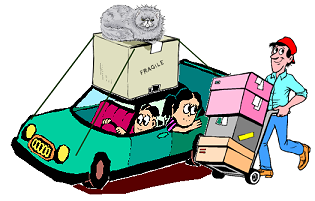Moving house with a cat

Preparing for the move
Moving home is always stressful , but moving with pets makes it even more complicated. Therefore it is important to plan ahead. Although you should not let the move drive you to the edge of a nervous breakdown, it is very unwise to trivialise the amount of work involved. Do not delude yourself that your cat is just another package to be lugged from A to B. Cats are very territorial and more conservative than an aged maiden aunt. Any change to their routine stresses them, and a move is stressful both because of the short-term disruption it brings and the long-term lifestyle changes which follow.
To begin with, packing - the moving of the familiar landmarks of your cat's life, the invasion of removal men and the associated noise will bewilder and disturb all but the most adventurous of cats. So rule number one is to ensure that your cat has a safe place during the move. It's no use her trying to hide under the sofa if two large men are going to pick it up and carry it away. If you regularly house your cat in a cattery, for example when you go on holiday, it may be wise to shelter her there from the trauma of the actual move. Otherwise prepare a quiet room in the house where your cat can hide out. Move the cat toys, litter tray, cat carrier and the cat food into that room a few days prior to the move. That way the cat will find the room familiar and comfortable once the move gets under way. Make sure that everything which will be moved to the new place is removed from her room before settling the cat in there. It is particularly important for the cat that the removal people are as far out of sight and out of mind as possible. Quite apart from easing the mental wear and tear on yourself and the cat, no-one wants a removal man tripping over the cat whilst carrying the family china, or to spend the last hours of the move trying to coax a reluctant cat down from the chimney.
Make sure you have a good cat carrier ready. Never transport a cat in a car without one. If you are moving long distance, it may be advisable to take your cat on occasional short drives. This way she will get used to the car, and you will be able to gauge her (usually deeply disapproving) reaction. Long distance movers should also take the time during the month before the move to take their cat for a general check-up with the vet and get a vaccination update. This will reduce the need to find a vet at short notice in the new location. Even if your cat does not normally wear a collar, consider using a quick release collar for the day. Fit it with your new address and phone number. If your cat is microchipped, do not forget to inform petlog (pet database) of the change of your address.
If you are moving into rented accommodation, check that pets are allowed. Never assume that this is so, and always try to get the permission of the property owner in writing, preferably as a part of the rental agreement.
The day of the move
Put the cat in her room and close the door. Make sure that the removal people know that she is there and do not accidentally let her out. Never let the cat out during the actual move. A stressed cat may hide or run away, which will add considerably to the excitement of the proceedings. Only give a light meal on move day. By now you should know how well your cat travels; if badly, do not feed her at all. Tranquilizers should be used with caution, and only as a last resort. They do not work on some cats, and others tolerate tranquillizers even less well than travel.
Pack everything first. Once everything is ready, collect the cat. Check that the cat carrier is secured. Then check it again. Then pack the remaining things from the cat's room. The cat should travel with you; NOT with the furniture. Cats, just like people, can get car sick. Put plenty of absorbent material at the bottom of the cat carrier, and don't be surprised if the cat empties her bowels into it over the course of the journey.
In the new house
When you arrive in the new house, a similar rule applies - designate one room, and put the cat in it. Make sure she is surrounded by familiar things - her usual toys, baskets and food bowls. It is a good idea to keep the cat in the cat carrier until the removal people have gone and things quieten down. Make sure that all the windows are closed, and than you can let her out of the cage. I would suggest leaving her in the room for a couple of days, while you are unpacking. That will have two advantages, she will be out of your way, and she will have time to adjust to the new environment.
Visit her room often. The cat will be more assured by your company. Introduce the usual routine. Avoid a tendency to overcompensate by giving your cat too much attention since this may produce behavioural problems later on. Once your cat becomes more confident in her new surroundings you can allow her to explore the rest of the house. Cats like the familiar. If you have furniture arranged roughly as before, she will love it. (Though we accept that there might be other priorities involved here.)
If you are transporting more than one cat you need to be aware that in new and unfamiliar situations, an anxious cat may take it out on her companion - this is called transferred aggression, and is not uncommon. In the event of any tension between the cats, take care to keep them septe before such aggression becomes a habit.
Venturing outside
If your cat is naturally an outdoor cat, she will eventually want to explore outdoors. However, make sure that you keep her indoors for at least 10 days to two weeks. This will allow her to get used to her new house and accept it as her base. Otherwise the cat may try to return 'home'. This is more common, but less disasterous, if the distance between the old and new house is relatively short. However, some cats have attempted to make the journey across half a continent. Even more incredibly, one or two are said to have suceeded. So make sure that the new occupants of your old house know what to do if your cat (or cats) turn up on the doorstep.
Fortunately the chances of the cat going walkabout decrease greatly if the distance between the houses is relatively large (larger than the cat's roaming territory). Nevertheless, if the cat is let outside too early, she may try try to find her old home and get lost in the process. When you do let her out for the first time, do so in the morning (so that you have more time to look for her if she does get lost) and before she has eaten breakfast (so there is less chance of her going far in the first place.)
Territorial disputes
Cats are very territorial and it may be that a neighbour's cat has already claimed your new garden for itself. In this case your cat will feel a bit uneasy about 'trespassing'. When you first let her out, stay with her in the garden. She will feel more confident with you there and other cats will be more inhibited about confronting the intruder. Doing some early gardening is a good idea. Such activities as trimming the hedge and cutting the grass assure the cat that she is in home territory, and help her to assess where the borders of that territory lie. Nevertheless, your cat will have to stake her claim. Expect a lot of hissing and posturing, possibly the occasional yowl and even some flying fur, but eventually the cats will work things out between themselves. If you think your cat has been involved in a punch-up, check her carefully for bites, and if there are any, take her to the vet asap to prevent potentially dangerous infection. As with humans, cat's mouths are bacteria farms, and any bite that penetrates the skin can cause an abscess. For more information about cat bites see our article: First Aid - cuts, bites and burns.
If you have a cat flap, consider locking it in the short term. It's tough enough for your cat to defend the garden and knowing that home itself is insecure may be stressful enough to cause behavioural changes such as toileting in different places or spraying (you can read more about cat flaps in our "Cat flaps" article in a "Get a Cat" section).
Conclusion
Moving home is tough - for you and for your cat. That said, though they might complain bitterly during the process, in the end most cats accept being translocated stoically, if not happily. Cats are the ultimate pragmatists.

